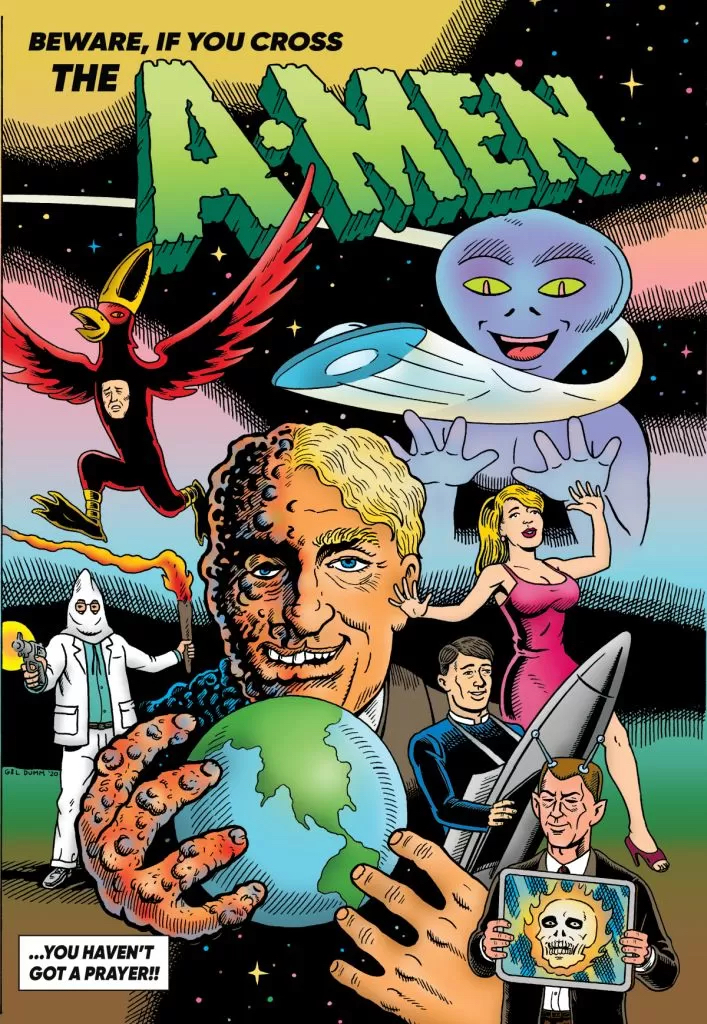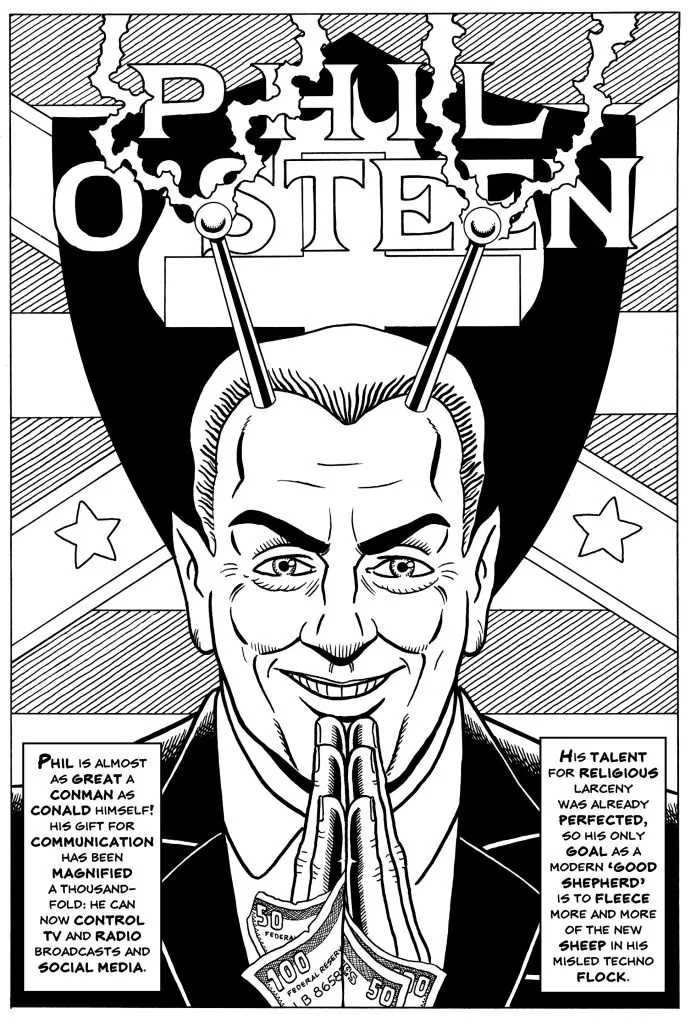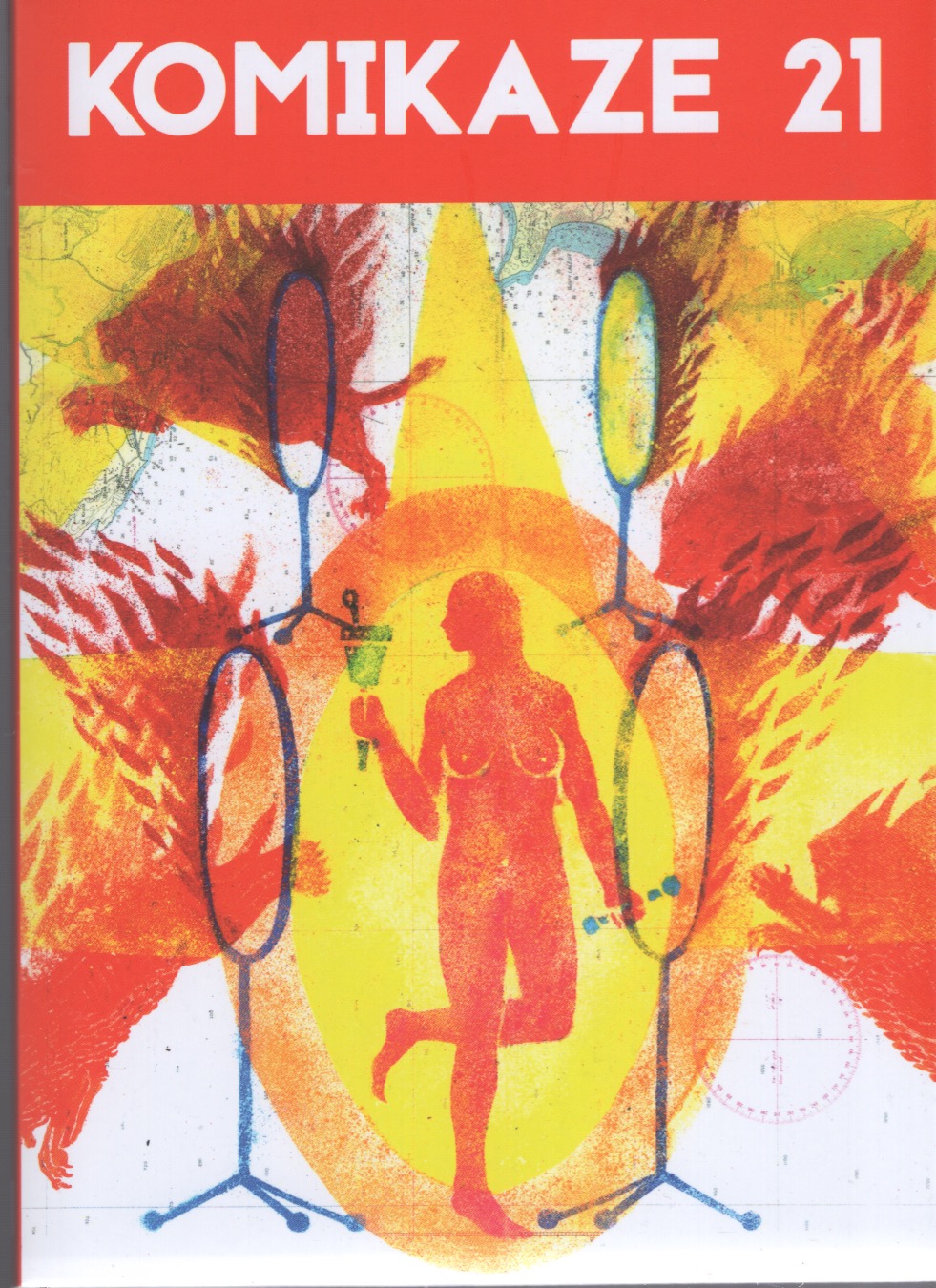The Essential Spread Love Comix. Uncle Gil, ed. (Spread Love, 2022).
A-Men. Characters and story by Scott Kraynack & Gary Dunn (Malenky Lizard Press, 2022).
Komikaze 21. Ivana Armanini, ed. (Komikaze, 2022).
I.
If your interests are satisfied by mostly one-page black & white stories featuring vomit, breasts, drunkenness, vaginas, drugs, homicide, penises, oral sex, genital mutilation, oblivion, intercourse, and a single nicely-drawn tongue, Essential Spread Love may suit your spring picnic.
But I’m 80, so, oblivion aside, I don’t see much of this in my future. Or that pondering it enriches my present. That said, half a dozen stories caught my eye and mind. Which, in no particular order, are...
- Mike Diana. “The Picnic.” 'Maturity' is not a word I would have expected to associate with Diana, but here it is. Greta Thunberg he is not, but his two characters’ recognition–SPOILER ALERT–that they need not commit suicide because man’s treatment of the planet will do that for them, squarely alines him with some of the deep thinkers on the subject.
- Glenn Head. “Lewd Laffs.” A traditional (picture-caption) gag cartoon, which spins an old joke, The Aristocrats fashion, into the outer reaches of the obscene. I laughed.
- J. Webster Sharp. “Net Curtain.” Superlative draftsmanship in service of unsettling imagery and perverse content. (And a terrific, if unlikely, penis, for those whose tastes run in that direction.)
- Kyle Gunn. “Untitled.” A harrowing meditation, in lettering tightly-packed to near illegibility, on isolation. A seemingly personal outcry and the most direct, unfiltered statement in the book, it touches the heart. The illustrations seem an afterthought, even a distraction; but without them, I guess, it wouldn’t be a comic and not included.
- Anna Lukina & Theophile. “Passing Time.” At three pages, the longest of my favorites. An apparent father leads his apparent child, hand-in-hand, wordlessly, past buildings representing stages of life (“Nursery” to “Cemetery”). Over six consecutive panels, the two figures progress from the left side of one toward the right edge of the last, without changing posture or expression until, at the cemetery, the father lifts the child to look inside, while the child, anguished, looks back at us.
- F.M. Oblak. “Death Talks.” I was surprised this one spoke to me. But, upon reflection, I think it’s immediately following “Passing Time” increased its impact. A German Expressionist-influenced rendering of a sickle-bearing Reaper announces bleakly but gleefully he is coming for us all. Like I said, I’m 80, plus, oh yeah, with a damaged heart, so you see the connection.
II.
“The world is too much with us; late and soon...”
Or so Scott Kraynack and Gary Dunn seem to feel.
And responded with a 40-page story, to which they added (black & white) visual art, accompanied by some 11 other cartoonists, whose styles vary from the realistic (nice job, Michael Damon Heasley), to the editorially-page exaggerated (an effective Sam Blanchard), to the humorously faux-demented (a gonzo Joe Archibald) and the near EC-level-in-hair-and-drool (Tim Switalski). One–the esteemed Denis Kitchen–contributes a page which barely connects to the matter at hand, but it must have been nice for the authors to attach his name to their book.
The premise is that the universe houses multiple dimensions parallel to our own and that in one “dark corner” is a world populated by “doppelgangers... living out lives that are... echoes of ours.” If that interests you, the book can be purchased from the publisher, Malenky Lizard Press ([email protected]), or the distributor, Last Gasp.
Do this immediately.
For I am about to spoil another plot.
Five of these doppelgangers are introduced in unbalanced fashion. Each receives a single introductory page summarizing their past and present, but these are followed by as-few-as-two and as-many-as-nine additional pages. This differential is not earned by the importance to the narrative of the doppleganger in question, and frequently these pages only amplify what the prefatory one has laid down. They do, however, set the stage for a significant event which, itself, sets the stage for–but the book does not deliver–even bigger events to come.
Like what we have is an “origins” issue for a team of super-villains about to embark on a series which may not end until we do.
(It’s still not too late to order.)
But if you are hanging with me...
The dopplegangers are a Catholic cardinal dedicated to the well-being of all of God’s creatures; a mega-church minister and master of conservative media, who craves wealth; a sex-crazed pedophile priest with a perpetual 18-inch by 4-inch hard-on. (Sorry penis fans, it’s off-camera at all times); a white supremacist Nazi-symp FBI agent; and Conald Dumpster, a lying, cheating, thieving corporate magnate, who resembles the man MSNBC anchors reflexively refer to as our “disgraced, twice-impeached ex-president.”
Personally, I am struck by what seems an over-representation of clergy at the expense of those who earn a living through government disservice or amuse themselves by directing billions of dark dollars into socially regressive causes. But to each his All-Vile Team own.
(Last chance: [email protected])
These five find themselves on a plane under the control of a demonic flaming unbodied skull, who crashes it into a swamp polluted by illegally dumped–by Dumpster–toxic and radioactive waste. This sewage synergy transforms the men into enhanced mutant versions of what each had been, empowering them to achieve all they had desired, presaging world ruin. (It is not explained why, if the evil became more evil, the saintly cardinal did not become more saintly, unless he was pissed at God for tossing him into the swamp. If so, Job took his calamities better.)
The book felt like Kraynak and Dunn venting. I can applaud that. (No punches pulled, except for the blacked-out penis.) But they don’t just preach to a choir; they preach to its most fervent members. I understand their disgust. I recognize their bleakness. But I do not see they have added to understanding, even of the bleakness, or gestured toward taking any action amidst it, except for having their followers nod, “Right on.”
Where is the startling? The shudder? The awe? The suck of breath at the uniqueness? When “Conald Dumpster” is your wit at its sharpest, you might consider a script doctor.
III.
It’s not like, on first glance, things look brighter in Komikaze - except for most of its 128 pages being in color. A past award winner at Angoulême, the current issue offers contributions from Croatia (12), Slovenia (3), Poland (2), Japan (2), and Montenegro, Germany, Italy, Austria, France, Taiwan, and Brazil (1 apiece), and contains its share of skulls, penises, murders, plagues, depression, self-mutilation, demonic possession, mental illness, economic exploitation, depression, starving dogs, eradication of elephants, and human extinction from trypophobia. (I had to look that up.) But interspersed throughout are two teddy bears, a sunny dispositioned pussycat, and engagements with the minutiae of life rendered in a potpourri of startling, engaging, rewarding-to-contemplate visual styles, uniqueness piled upon uniqueness.
Images are commonly abstract. Representation is not a major concern. Linear narrative is often absent. Language is often missing. Readers’ eyes will engage with panels; but then comes free play, and what results is anyone’s guess, as individual minds work it out with individual authors. The challenge might drive away many, but those who stick around will benefit. Like muscles, minds need exercise to thrive. You may find you can’t come up with words to express your experience, but even if you can’t, it doesn’t mean you are not having one.
Let’s look at two artists who engaged me.
1.) Ivana Armanini, about whom I have written before, presents 17 pages, which she had planned as being divided into three parts but grew into a single “Big” story, that, she says, aligns with her vision that everything in the book “work... in one unity.”
Armanini is among the most purely abstract of the artists represented. Her work blurs the line between “Fine” and “Comic” art to near indistinguishability, except for hers appearing on pages and not upon walls. Here she limits her palette to a compelling-in-its-restrictedness black & white, cream, and red. If there is language, unlike in most of the book’s strips, it may go untranslated into English. Perhaps it is presented in mirror-writing; perhaps it is not language at all. A word, like “Pupak” (“Belly Button”) may give you an idea of what is being depicted on the accompanying page, but “Chopping Wood Like Van Gogh His Ears” offers little textually to grab onto, and “DIY or DIE,” which lead into skulls and breasts and rib cages, conveys a clear sentiment without an obvious correlation to what is displayed.
The ultimate effect is an appreciative “WHEW!”
2.) Damir Stojnic’s “Conflagration - Contin(g)ents” consists of 11 pages, some double-, and some single-paneled. The visuals, with golds and blacks predominant, are glorious. Each panel but one presents portions of a map or globe or both, none contemporary. There is language: Latin, for sure; maybe Italian, maybe French. “China” appears on the corner of one map; “Brasilia” identifies another. The continent of Africa is recognizable.
Superimposed on the maps and globes, sometimes to the point of all but obscuring them, are dark shapes. Sometimes the shapes are unidentifiable and sometimes distinct: playing card-like kings; human hands; human silhouettes; a black butterfly. When a blood red knife and fork, each gripped in a separate hand, are superimposed over Africa, the meaning seems clear. That clarity can influence what one makes of some other images, but from still others only beauty and oddity come through.
This is splendid, jarring work.
IV.
To recapitulate:
We are subject to time’s whims.
We are subject to other’s incapacity for self-control.
There is no escape from the first. There could be a way to avoid the second, but experience suggests it unattainable.
These comics express a common attitude: We are fucked.
Which does not rule me out as an audience.
When I pick up a book, I am not looking for uplift. (Promise me I will “Feel good again,” and hear the door slam behind me.) Ask me what I really think, and I will tell you, “The drives of those motivated by greed and/or power will overcome the best within the rest of us.” (Watch the news; read Elizabeth Kolbert; see the Doomsday Clock near midnight. Who needs parallel universes?)
Still...
I have a friend from grade school whose daily email is replete with worries about avian flu, COVID, Republicans, the Supreme Court. (The dangers from AI, quantum computers and TikTok have not yet creased her brow.) She worries about herself, her children, her children’s children, her siblings, her siblings’ children, her siblings’ children’s children, her friends, her friends’ children and their children. She checks daily weather reports for each city where any one of them reside to see what is bearing down upon them. (It is like a blanket of empathy is smothering her within her crib.) As I read her emails, I think of Budd, a café pal, whose go-to quote is Mark Rylance in Bridge of Spies who, when asked by Tom Hanks if he is worried about being returned to Moscow, replies, “Would it help?”
Does it help? I do not ask my friend.
The truth is–despite the thundering hooves of nearing apocalyptic horsemen–one can feel wonderful. Embrace relationships; work; look at the sky and revel in the wonder of being.
Did Sisyphus ever glance at the view or appreciate the ground beneath his feet? His mind need not have always been on his rock.










